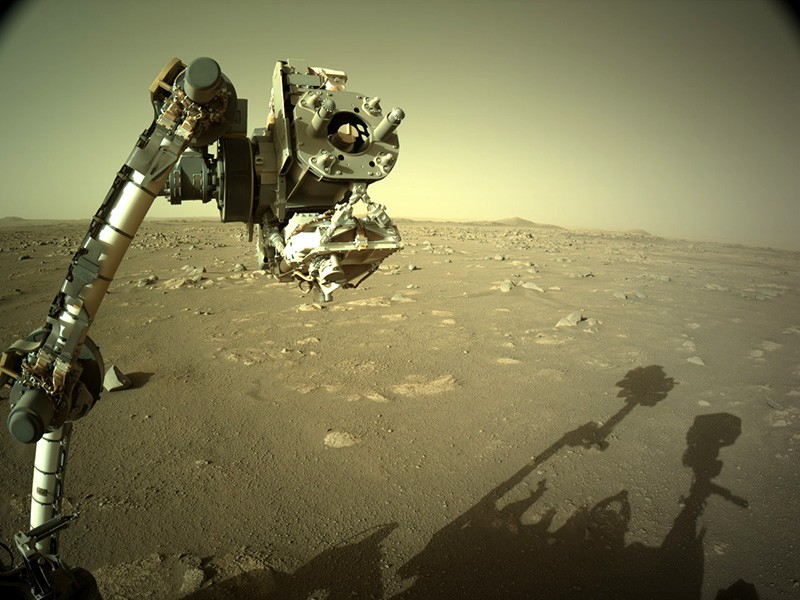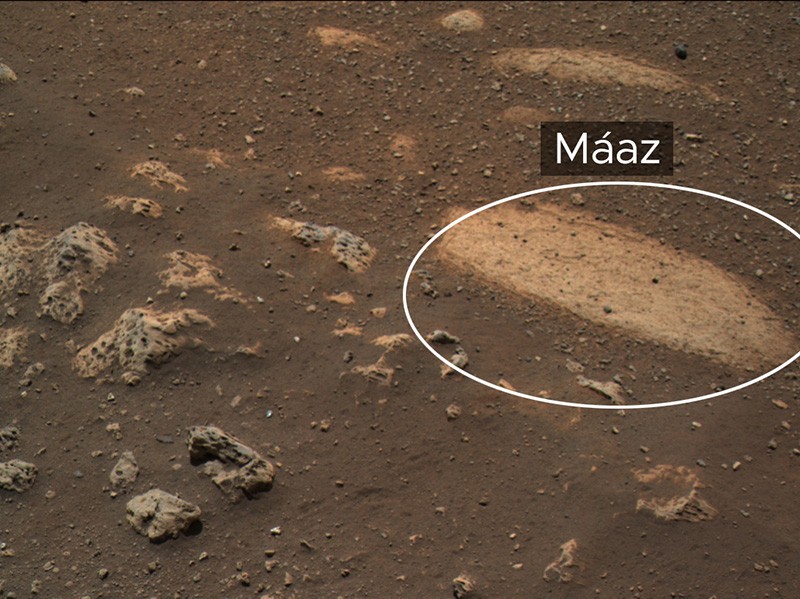
[ad_1]
NASA’s Perseverance rover has had a busy first month on Mars’s surface. From Jezero Crater, where Perseverance landed on 18 February, it has been doing as much geology as it can — snapping pictures of its surroundings and analyzing the rocks nearby. Already, team scientists have determined that several of the rocks are chemically similar to volcanic rocks on Earth, and that wind and water have eroded some of them.
“Everything is going great so far,” said Kenneth Farley, a geochemist at the California Institute of Technology in Pasadena and the mission’s project scientist. He and others described Perseverance’s progress on 16 March at a virtual meeting of the Lunar and Planetary Science Conference.
As planned, the rover’s main science experiments will have to wait a few more months, while engineers continue to test its scientific instruments and prepare for the first helicopter flight on another world. Eventually, Perseverance will deploy an arsenal of tools, including a drill bit, a close-up camera and multiple chemical sensors to hunt for signs of past life within Martian rocks.
In the meantime, team scientists are plotting how the rover might travel from its landing site — named after the science fiction writer Octavia Butler — to the 40-metre-high cliffs of the ancient river delta that drew Perseverance to Jezero in the first place. The delta, deposited billions of years ago by a river flowing on Mars, would have been an ideal landscape for ancient microbial life, if it existed. But a treacherous dune field lies between Perseverance and the delta, which the rover cannot cross. Researchers are discussing whether to drive clockwise or counterclockwise around the dune field; the latter would be a shorter trip, while the former would pass next to a greater variety of interesting rocks.
But none of this is likely to happen until June at the earliest. First, Perseverance must drive to a suitable spot to test Ingenuity, its helicopter. The spot will probably be a rock-strewn area not too far from the rover’s current location. There, the rover will lower Ingenuity from its belly, drive off a safe distance and shoot a video as the helicopter takes to the Martian skies. “We’re looking forward to those historic, aviation-first movies,” said Jim Bell, a planetary scientist at Arizona State University in Tempe who leads one of the rover’s camera teams. The helicopter test comes first because Ingenuity will fly with the rover as it drives, helping Perseverance navigate its way across the landscape.
Until that first flight test, expected in the coming weeks, team scientists have been exploring the rocks around the landing site. Immediately surrounding the rover are lighter-coloured rocks peeking out from dark soil. Perseverance has used a laser-based instrument to determine that several of these rocks, including two that team scientists named Máaz and Yeegho, are chemically similar to basaltic rocks on Earth, which form from molten rock. The instrument zaps rocks with a laser to vaporize small portions and study their chemical makeup. Through this analysis, the scientists see that Yeegho shows signs of having water locked up in its minerals, said Roger Wiens, a geochemist at Los Alamos National Laboratory in New Mexico who is head of the laser instrument team. These discoveries fit with what scientists had expected from Jezero — that it might have volcanic rocks on the crater floor, which could have interacted with water over time.
Many of the rocks around the landing site appear to have been sculpted by strong winds, including a dark, odd-shaped object that scientists have dubbed the ‘harbour seal’, for its similarity to a seal perching on a rock. The winds seem to have scoured the rocks primarily from the northwest, a direction that matches the major wind patterns calculated by global circulation models for Mars, said Bell.
Another dark-coloured rock looks as if it has been weathered not by wind but by water, said Farley. That suggests it could have been tumbled around in running water — perhaps in the ancient river flowing into Jezero, or in its lake. “This is quite promising for our study,” he said.
Perseverance scientists have been giving informal names to rocks, craters and other objects around the landing site in the Navajo or Diné language. Following a tradition from earlier Mars landings, the scientists are choosing themes for names based on geologic maps of Jezero, which are divided into sections named after national parks on Earth. Perseverance happened to land in the section named after Canyon de Chelly National Monument, which is in Arizona on Navajo tribal lands. Aaron Yazzie, an engineer on the rover team, is a member of the Navajo Nation and has led the effort to coordinate the names. Máaz, for instance, means Mars, while Yeehgo is an alternative spelling of the word for ‘diligent’.
After the helicopter test, and before Perseverance sets off for the delta, the rover will probably drill its first rock sample into the dark, fractured rock that makes up much of the Jezero Crater floor. Scientists have not yet determined whether this rock is volcanic, but if it is, it could help determine the age of the crater floor because molten rock traps radioactive elements that decay at a predictable rate and can be used as a clock to date when the material was originally molten.
During its mission, Perseverance will collect approximately 30 tubes full of Martian rock and soil, laying them down on the Martian surface so a future mission can retrieve them and fly them back to Earth for scientists to analyse, no earlier than 2031. It will be the first-ever sample return from Mars.
[ad_2]
Source link

